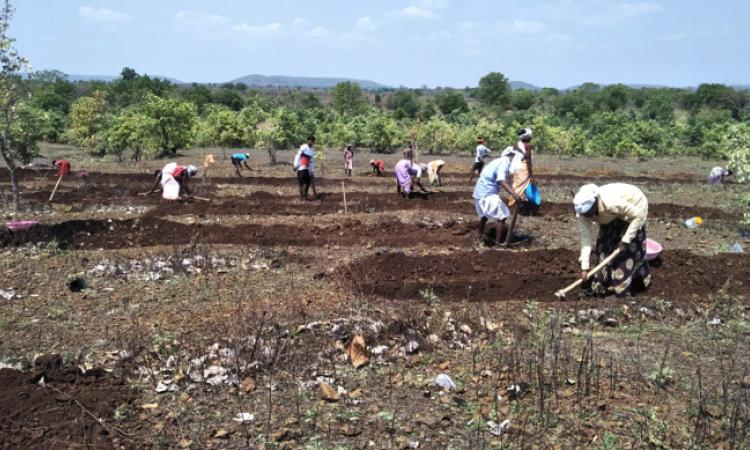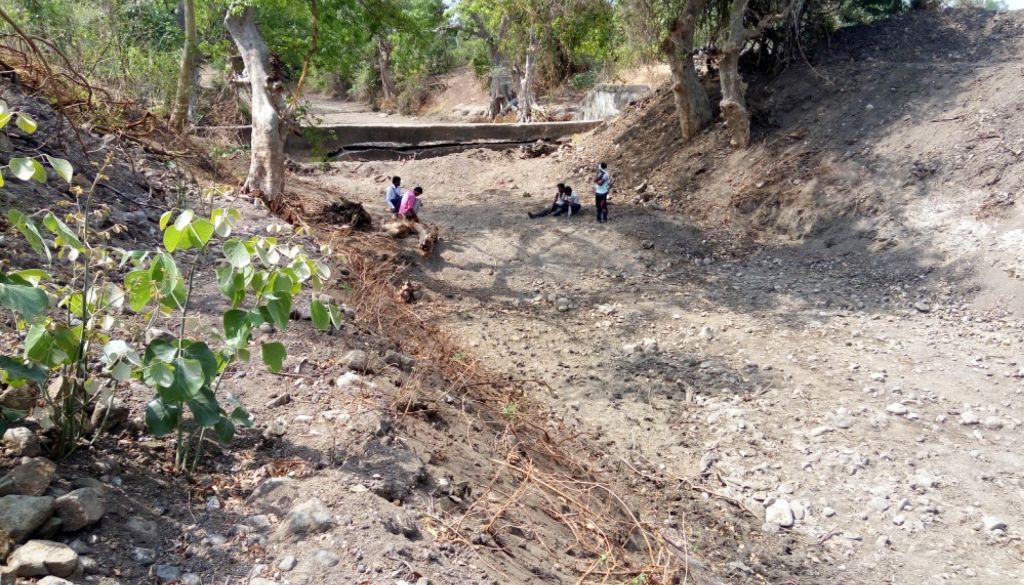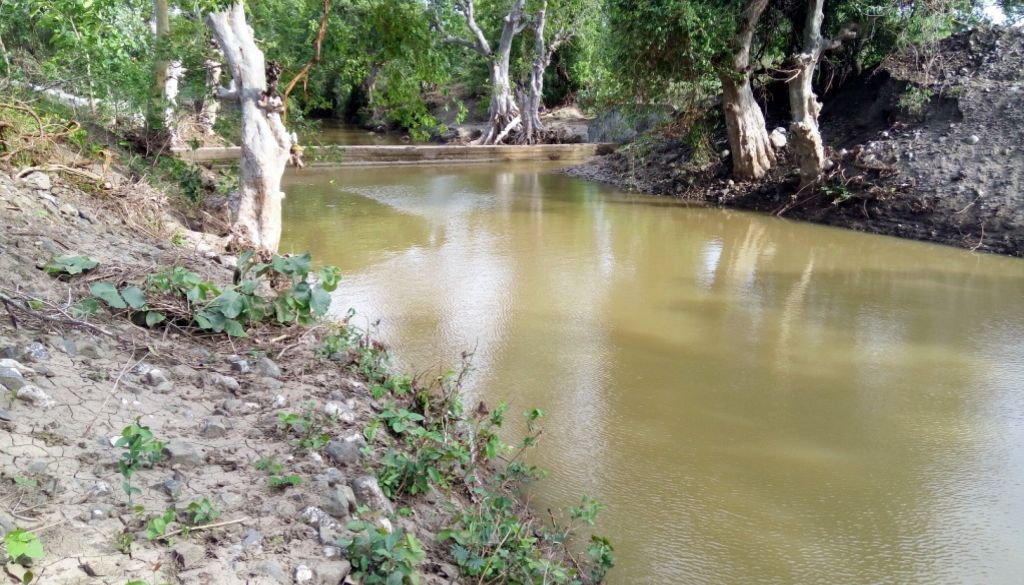
Located in the Ghatanji block in Yavatmal district of Maharashtra, Jarur village has seen a good monsoon this year. Good rains are particularly critical to the village, as out of the 452 households in the village, over 300 practice rainfed agriculture - mainly growing kharif crops like cotton and rabi crops like soyabean and red gram.
Not only did rains come a week early due to the pressures created by Cyclone Nisarga and Cyclone Amphan, but the village also recorded 147.4 mm of rainfall in just seven days. This filled the water harvesting structures and ensured sufficient water availability for the community’s needs.
The remote village in Ghatanji has been historically suffering from water scarcity. The Jarur Hiwardhara nala, which passes through the village and from which it gets its name, dried up during the summers and people had to buy tanker water to fulfil their drinking water requirements. The community also faced severe fodder and water scarcity for its livestock as the commons under the village were barren and depleted.
It was at this point in 2014 that the Foundation for Ecological Security (FES), a non-profit organisation working towards ecological restoration started its intervention by bringing together the community to restore and manage their common resources for better ecological and economic benefits.
Considering the importance of the Jarur nala for recharging the community well (through which water was pumped to the overhead tank for supply to the village), the communities decided to start work for restoring it. Discussions held zeroed down on repair of the existing nala bunds on the Jarur nala.
To enhance the planning process, the community resource person, who was trained in the use of Composite Landscape Assessment and Restoration Tool (CLART), decided to use the tool to check the effectiveness of the structures. CLART indicated medium recharge potential in the zone and assured the communities that repair of nala bunds would be the correct way to go. Armed with this information, the first bund was repaired in 2014, adding 13,816 cubic meters of storage capacity to the nala.
The repair of the first nala bund proved successful and water was available in the nala till May. There was a marked improvement in groundwater levels and the community well had enough water to meet the household water needs till monsoons arrived. Encouraged seeing the impact, the communities decided to renovate the second nala bund by desilting and repairing the cracks. Construction of new bunds was ruled out as it cost ten times the repair costs.
In 2016, the second bund was repaired, enhancing the water storage potential of the nala by 4,653 cubic meters (cum). The increased water storage in the nala also enhanced water flows to the Saikheda dam, situated 2.5 kms away and to which the nala water drained out, reiterating the importance of ridge to valley approach for restoration of a landscape.
The increased water availability in the nala also created a conducive environment for undertaking restoration work on the adjacent commons. The communities, leveraged MGNREGS and undertook efforts to restore their 338 acres of commons (revenue wasteland in this case), after taking all the necessary permissions from the gram panchayat. Along with trenches and planting on the commons, farm bunding and construction of two farm ponds were also undertaken to enhance the water availability of the farmlands.
Before treatment

After treatment

While the planning and repair of the water harvesting structures were going on, FES also worked with the community to improve water literacy and promote a culture of judicious water use. The communities were introduced to a Package of Practices (PoP) including farm preparation, cross ploughing & line sowing, application of cow dung, compost, intercropping and minimum using of fertilizers & pesticides along with Non Pesticide Management (NPM) - Jeevamruth, Dasparni ark, Neemark, demonstration of bio-decompose etc.
The engagement, which started with 23 farmers covering 28.6 acres of farmland in 2014-15, now covers 67 farmers undertaking kharif crops (cotton, red gram and soya bean) and 18 farmers undertaking rabi crops (wheat and gram), covering a total of 100 acres, 78 acres of which is also covered under microirrigation practices.
Working on the demand side, communities were introduced to water games and crop water budgeting exercises and made aware of the village’s water availability and crop and other choices that would prevent overexploitation of the common water resources.
The renovation of bunds on the nala has had a manifold impact on the village. The Jarur Hiwardhara Nala, now a perennial stream, recharges the community well and provides drinking water to the village round the year. The nala also suffices the drinking water needs of the livestock. The renovation of the bunds along with the restoration of commons through MGNREGS has provided villagers with work during the off-season.
This year, the pre-monsoon MGNREGS work including Continuous Contour Trenches (CCTs) and Cement Nala Bunds (CNB) on the common land added 1,976 cum to water storage potential, while also generating 1,220 person-days of work.
The increased water in the nala has helped recharge the close-by farm wells, allowing farmers to take two crops a year. Members of the fishing community - Bhoes, now catch fish in the check dam, enhancing their earnings. The local biodiversity is also flourishing and villagers report seeing different kinds of snakes, insects and scorpions along the nala.
The communities of Jarur are committed to up-keep of the nala bunds so that their water resources never deplete again. They are well aware of the importance of harvesting and storing rainwater for meeting their needs, and have established several rules and norms for use of common resources.
Some farmers, overexploiting the groundwater, were penalized by disconnection of their electricity supply, which was restored only once the farmers agreed to abide by the rules and norms set by the institution. Cultivation of water intensive crops like sugarcane is discouraged. Communities are moving towards undertaking crops that allow the most efficient use of stored water.

The communities are also working to further regenerate their common lands so as to become self-sufficient in terms of fuel and fodder availability, along with enhancing the ecological benefits like improved water flows, enriched soil nutrients etc. They have set up rules to avoid overgrazing and cutting of green trees for fuelwood. The households are being assisted in obtaining LPG connections through the Pradhan Mantri Ujjwala Yojana (PMUY) to meet their cooking fuel needs.
The degraded common lands are being regenerated and restored in a phased manner so that the communities have access to enough grazing lands at any point in time. Once the land being worked upon is regenerated enough, it is opened for grazing and another parcel of land is closed for undertaking regeneration activities. The collective action at Jarur has brought about positive changes in people’s lives and the community is committed to improving the governance and management of their common resources.